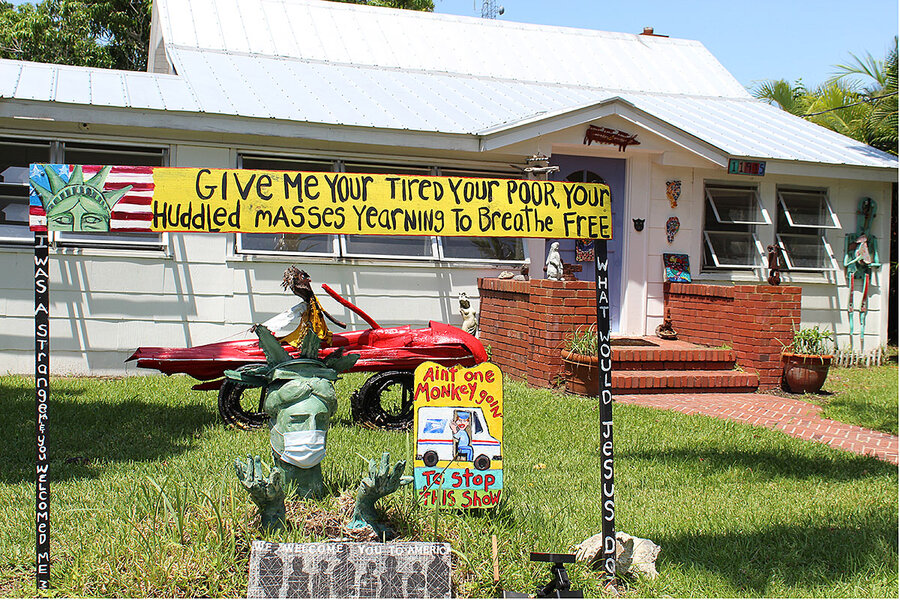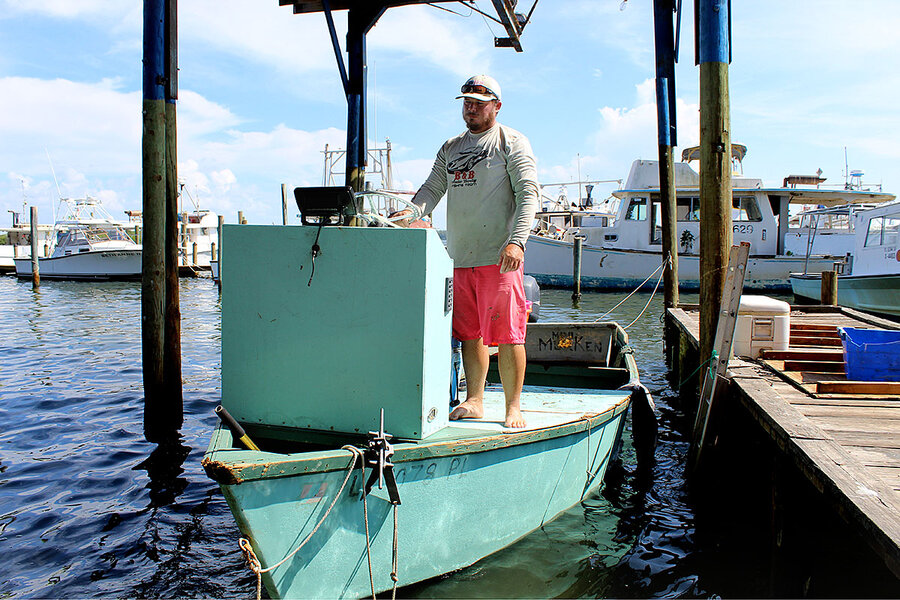Deep-water fish farming in the Gulf of Mexico: Who benefits?
Loading...
| CORTEZ, Florida
A proposed deep-water fish farm about 40 miles off Florida’s coast could reshape the world’s seafood industry and upend the lives of the region’s fishermen.
If approved, Velella Epsilon would be the first aquaculture project in federal waters off the contiguous United States. There, globe-shaped pens would cultivate up to 64 million pounds of sushi-quality almaco jack fish meat each year, creating stiff competition for those who ply the Gulf’s wild-catch fisheries, as well as opportunities for fishermen hoping to supply bait for the project.
Why We Wrote This
When it comes to balancing food security with protecting ecosystems, there’s no such thing as a free lunch. An ambitious project off Florida’s coast could bring down the price.
At stake is whether markets and permits are enough to tackle the larger ethical questions about how to integrate fish farming into the complexities of a system that includes not just the Gulf of Mexico, but Americans who make a living off it.
“How much of the landscape and the seascape should human beings be using?” asks Philip Cafaro, a philosophy professor at Colorado State University. “You have to be explicit about what your goals are. If it’s to maximize profits in the fishing industry, that’s one thing. If your goal is to maximize output to the fishing industry in order to protect communities, that’s a very different one.”
The long, choppy quest to open up the Gulf of Mexico to large-scale fish farming began, in a way, some 30 years ago on the black pearl diving docks of Micronesia. That’s where the Australian businessman Neil Anthony Sims first met the American marine biologist Kevan Main.
Their paths diverged – his to Hawaii to develop deep-water fish farming, hers to Florida to head the Mote Marine Laboratory & Aquarium in Sarasota – but the two remain key figures for a project that could transform not just the American dinner table, but also the economies of fishing ports from Alaska to Florida.
Velella Epsilon – the first fish farm in federal waters off the contiguous United States – would operate in the Gulf of Mexico, about 40 miles from Florida’s coast. Globe-shaped pens would hold fingerling almaco jack, a member of the amberjack genus, that would grow into 4-pound market fish within a year. If scaled with corporate investment, the project could eventually yield 64 million pounds of sushi-quality meat a year, enough to dramatically reshape the world’s seafood trade.
Why We Wrote This
When it comes to balancing food security with protecting ecosystems, there’s no such thing as a free lunch. An ambitious project off Florida’s coast could bring down the price.
“People paying attention to the global impacts of humankind on the planet are saying we need more aquaculture, and offshore fish farms are a really scaleable, sustainable, low-impact form of aquaculture,” says Mr. Sims, the co-founder and CEO of Ocean Era, the company behind the Velella Epsilon project, in a phone call from Hawaii. “There’s deep water. You are further from shore. The currents are better. You work within the assimilative capacities of the system.”
As Velella Epsilon gains steam even under heavy regulatory headwinds, that phrase – “assimilative capacities,” the ability for the natural environment to safely absorb pollutants – will be key in a broader gambit for U.S. protein independence. At stake is whether markets and permits are enough to tackle the larger ethical questions about how to integrate fish farming into the complexities of a system that includes not just the Gulf of Mexico, but Americans who make a living off it.
“How much of the landscape and the seascape should human beings be using?” asks Philip Cafaro, a philosophy professor at Colorado State University in Fort Collins. “You have to be explicit about what your goals are. If it’s to maximize profits in the fishing industry, that’s one thing. If your goal is to maximize output to the fishing industry in order to protect communities, that’s a very different one.”
In a big pond
In 1986, the newly independent Federated States of Micronesia imported nearly 20,000 pounds of black-lipped pearl oysters, a species known for its high quality black pearls, and raised them in Chuuk Lagoon. At first, little was done to develop the fledgling republic’s nascent aquaculture.
But as Micronesia’s black pearl industry began to shift to a more managed model in the 1990s, “we saw a transition from hunter-gatherer to farmer,” says Mr. Sims. “And it took years of bitter fighting. But now those communities have reversed a brain drain because there are now millionaires in those communities.”
Mr. Sims’ goal off the coast of Florida is much the same, he says. “The primary driver behind Velella Epsilon is to showcase it to the fishing community as a great asset.”
It's now unclear which government agency has authority to approve the Velella Epsilon project, but which would test the feasibility of fish farming in a high-risk environment. It also represents the latest effort to push aquaculture through the regulatory maze that binds the National Oceanic and Atmospheric Administration (NOAA) to eight regional fishery councils, which in turn set the rules for managing the wild stock.
The White House appears eager to open federal waters to aquaculture. With Executive Order 13921, President Donald Trump on May 7 ordered NOAA to winnow down regulations for both aquaculture and wild-caught fish. Last week NOAA announced that it would be creating 10 Aquaculture Opportunity Areas, including one in the Gulf.
But this push for open-ocean fish farming has faced legal hurdles. Earlier this month, a federal appeals court ruled that NOAA lacked the authority to take the lead in regulating aquaculture in federal waters, a victory for the environmental groups and fishing associations who brought the suit. Those groups have argued that open-sea aquaculture is too risky and too dependent on the market’s whims.
“A slice of the population looks at the oceans and thinks of them as a last, wild frontier, and to have farming in that last wild frontier is anathema to them,” says Paul Zajicek, executive director of the National Aquaculture Association in Tallahassee, Florida.
Ocean aquaculture is not without its environmental costs, such as escaped fish, parasites, and “fish sewage.” Though some of those problems are more endemic to near-shore fish farms, concerns remain among environmentalists and many Florida residents that deep-sea cultivation would prove even more complex, but with less oversight.
“It’s an ethical issue akin to raising tigers for consumption: You’re fishing up the food chain,” says Zach Corrigan, a senior attorney at the Washington-based nonprofit Food & Water Watch, which opposes the project. “I don’t think [Mr. Sims] represents what is really the best economic model for these fish farms, which is going to be cheaply produced fish out there on the fly. At that point you’re not competing against the imports, you’re producing expensive, high-grade product for your own dollars.”
Opening a can of worms
To James Bois, a commercial fisherman based here in Cortez, it’s unclear how a massive fish farm operation off the coast of Cortez will change his life. But he does know that unless Americans suddenly start consuming more seafood, his wild-caught fish – amberjack is on his list of allowable catch – will have to compete against Mr. Sims’ farmed almaco jack.
At the same time, fishing regulations deemed necessary to protect vulnerable stocks have reshaped Cortez. Today, the funky little slice of pre-Disney Florida is largely a bait fishery for larger fleet boats. If Mr. Sims began buying local bait to feed his fish, it could create a boom for Cortez, in the short term. Yet part of the plan to make open-ocean farming truly sustainable is to replace bait fish with a plant-based feed laced with algae oil. It takes 5 pounds of feed to build 1 pound of fish protein.
“Offshore farming can help us or hurt us. We don’t know which yet,” says Mr. Bois. “But one thing I know 100%: It will affect us.”
Market dynamics, court battles, and political battles seem far on the horizon from the Mote Marine Laboratory & Aquarium, on the outskirts of Sarasota. There, Ms. Main runs her marine workshop: tubs, PVC pipes, and notes on pH and salinity scrawled on wipe-boards. Ms. Main is the aquaculture scientist who solved the mystery of spawning snook. She helped pioneer pompano as a farmed fish. She has also farmed sturgeon and redfish.
Mote Marine Laboratory & Aquarium, Ms. Main points out, is not involved in the planning or operation of Velella Epsilon. But Mote has been contracted to provide some 20,000 fingerlings for the project’s initial cohort of fish.
As she leans over a massive tank, she points to 28-day-old almaco jack fry gorging on brine shrimp. “Look at those little tiny row boats,” she says.
Indeed, her problems are far more immediate, given her hopes to have the demonstration pen operating by December. She is losing more of the almaco jack fry than she was expecting, forcing a reevaluation of the feeding plan.
But what’s harder to control than salinity is perception. In a way, how a dream to farm the open oceans clashes with shifting values on land is embodied by her work.
“We should be producing food that we eat in this country,” she says. “It’s really important, because we will do it right, it’ll be subject to our regulations, and we know what we’ll be getting.”











